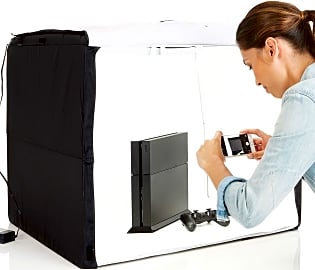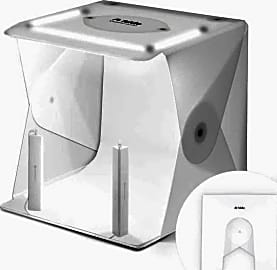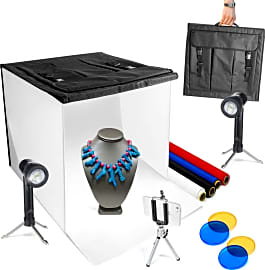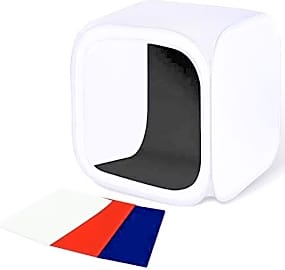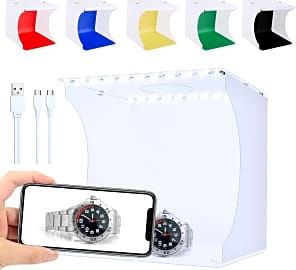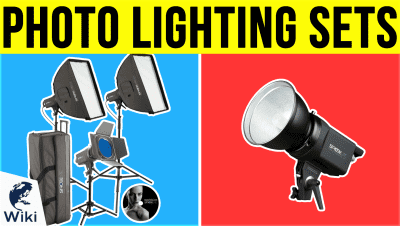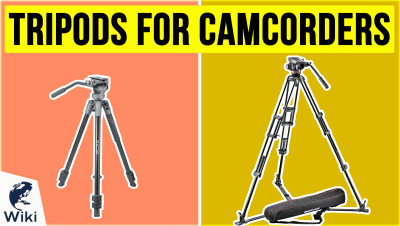The 9 Best Photo Light Boxes

This wiki has been updated 43 times since it was first published in September of 2015. Perfect for amateur eBay and Etsy sellers or for professional product photographers, these photo light boxes will ensure you get the right shot every time. Designed to provide a clean background and the perfect illumination without any shadows, they will enable you to capture any item in all its glory, and we've ranked them here by their construction, lighting quality, and ease of use. When users buy our independently chosen editorial selections, we may earn commissions to help fund the Wiki.
Editor's Notes
November 06, 2020:
There are fewer inexpensive light box models out there than at the time of our last ranking, which hopefully speaks to the overall quality standards of the category. A couple of our previous picks were either discontinued or felt redundant given the variety of newer models out there, some of which, like the Slow Dolphin Portable Studio, are improvements upon older light boxes.
We also added a couple of models that offer some great add-ons and accessories, such as the Orangemonkie Foldio2 Plus, which is available in a number of different bundles which include halo bars and a 360-degree turntable. The Emart Shooting Tent comes with a phone tripod and two different color gel filters to adjust temperature. And if you're looking to take your product lighting to the next level, and really fine-tune light intensity and temperature in your light box, we can point you in the direction of some quality light reflectors.
November 27, 2019:
With the incessant rise in Instagram product photography, particularly among influencers, just about everybody could make good use of one of these boxes, but some are a lot easier to use than others. Something like the MyStudio MS20 is a smart choice because it takes a lot of the guesswork out of creating an infinity curve that can make a product stand out against a seemingly non-existent white background. Other models might take longer for new shooters to get the hang of, with the occasional shadows or add hot spots.
Color rendering index was an important consideration, though that's become an easier thing for manufacturers to get right, as LED lighting technology has greatly cheapened the ability to nail a proper daylight balance from diode to diode, as opposed to relying on filaments or fluorescents to create roughly the same temperature.
Among the models that left our rankings, we sent off the Emart Studio due to availability issues, as well as the Elviros Professional Kit, which had suffered from some wiring problems that caused the lights to become unreliable.
Special Honors
Impact PLB-400 For the photographer in need of an extra-large controlled-lighting space, the Impact PLB-400 can easily accommodate an adult or two within its sturdy tent supported by steel tubing, but is still adaptable enough fold down into a handy carrying case. It has several diffuser options and each of its eight LED strips is individually dimmable. Working abroad? This model's got universal voltage, so all you have to do is plug it into an adapter. bhphotovideo.com
Proper Lighting For Great Photography
Masterful photographic lighting is that which can hardly be detected in the finished image.
Masterful photographic lighting is that which can hardly be detected in the finished image. Whether manipulated for dramatic effect, utilized to create an even uniformity of a product image, or used to recreate a scene that appears natural and untouched, lighting can help a photographer achieve the composition he or she wishes regardless of the actual lighting conditions present prior to illumination.
Sunlight has always been and remains the most widely used source of light for many photographers. Whether used as direct — or key light — falling squarely on the subject of the image, bounced off of a reflective surface to fill in and soften a subject, or used as ideal omni-directional light on a cloudy day or in the shade, sunlight is a powerful tool in the hands of a skilled photographer.
Of course the sun's brightness can be too potent or too unpredictable for many photo projects, thus the vast array of artificial lighting tools available today, as well as the many approaches photographers use when lighting a scene. The most common setup for the basic illumination of a single individual is three point lighting. In this arrangement, a key light is placed directly in front of the subject, a fill light is positioned to one side to soften the effect of the key light and reduce shadows, and a back light is positioned behind the person (or other object) to reduce shadows and add depth.
Often, however, rather than wishing to enhance and define an object with three point lighting or other setups, a photographer simply wants the subject or their photo fully and evenly illuminated, without a shadow or shading anywhere to be seen. Such lighting is most commonly used to capture images of a product for use in promotional materials. This type of universal lighting must be achieved either through careful arrangement of lighting in a studio, or through the use of a photo light box.
Choosing The Right Photo Light Box
There is a single primary distinction to be made between various photo light boxes: many photo light boxes come with built-in lighting, while others rely on additional lights, ambient light, or even sunlight alone. Choosing the right option for your purposes involves everything from the type of objects you photograph to how often you travel to the budget with which you're working.
However using a simple option like this either leaves you at the mercy of the lighting conditions you find, or else necessitates the purchase and use of a separate light kit.
All good photo light boxes offer an interior space a few square feet in size that can either diffuse or block the light around them, creating a uniform, virtually shadow-free interior. And all photo light boxes are designed to evenly distribute light shined into them, creating a neutral space perfect for additional and manipulated light or, if enough ambient light is present, ready for the photographer to start taking pictures.
If you usually snap pictures in a well-lighted environment, from a studio with plenty of windows to a living room with lots of high hats and lamps, you may well be able to get away with a light box that features translucent walls and no additional artificial lighting. These basic photo light boxes, sometimes called light tents as well, are also great for the traveling photographer, as most fold flat for easy transport and storage. However using a simple option like this either leaves you at the mercy of the lighting conditions you find, or else necessitates the purchase and use of a separate light kit.
On the other hand, if you opt for a photo light box with built-in lighting, you can always count on a bright, evenly lit area for your work. The only drawbacks to a photo light box that comes with its own lighting are price and less convenience for travel. Beyond that, these units are ideal, especially as you can always simply switch the lights off and create your own lighting scenario anyway.
Making The Most Of Your Photo Light Box
It's important to keep in mind that a photo light box is only suitable for the photography of rather small objects. If you want to snap images of people or of products (or other objects) much larger than the average loaf of bread, you may be relegated to the traditional studio setting.
Or you can light the photo box first and then use a filter on your camera to achieve the ideal look.
For smaller objects, such as jewelry, watches, books, and more, a photo light box is ideal for controlling your lighting environment. A photo light box offers even more control than a studio, in fact, by concentrating the lighted area into a space usually no more than two feet cubed.
There are myriad ways to alter the contrast, intensity, and color of the light inside a photo light box. You can use studio lights set to different color temperatures and further alter these using gels and scrims. Or you can light the photo box first and then use a filter on your camera to achieve the ideal look.
By lining the box with fabrics of varied colors (often included with the photo box's purchase) you can quickly and easily change the background of your photo shoots You can also use varied colors of fabrics to indirectly change the brightness and color of the light in the box by placing them out of view of the lens but where they can help absorb and/or reflect light. The more you experiment, the more you will master easily changing lighting color, brightness, and contrast using bounced or absorbed light.



